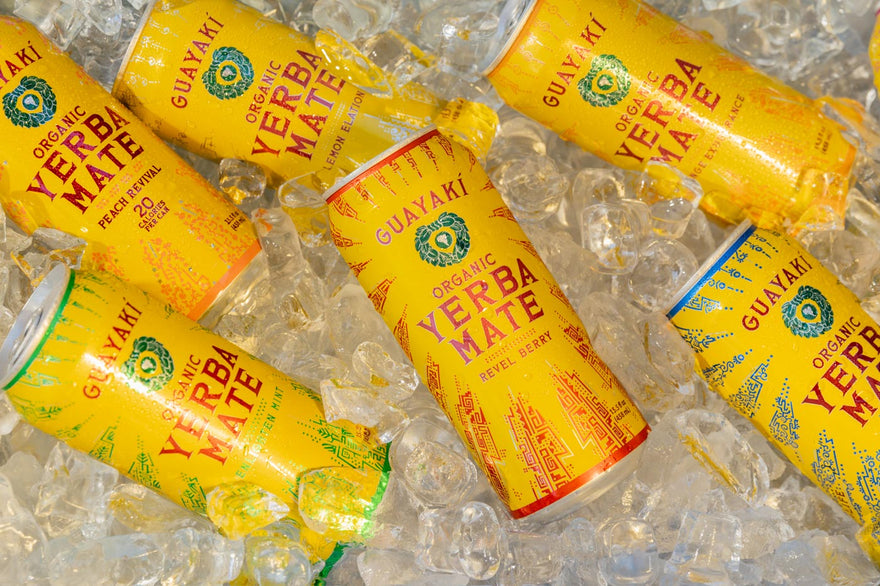Yerba Mate 101
Yerba mate (yer-bah ma-tay), known scientifically as Ilex paraguariensis, is a tree of the holly family that is native to the Atlantic Forest of South America [1–5]. In Argentina, Brazil and Paraguay, yerba mate is commonly cultivated [1,6–15], but in the forest, a mate tree can grow up to 30 meters (almost 100 feet) in height [1–5].
The consumption of yerba mate is related to the unique relationship between Indigenous Peoples and their forest environments developed over millennia through the constant interaction, foraging, and management within the forest and construction and exchange of knowledge and practices for generations, between and among peoples [16–24]. The knowledge that enabled the dissemination of the consumption and use of yerba mate originates from the Guarani (gwar-a-nee) people [20,21,25–27].
Indigenous Peoples, including Guarani [20,21,25–27], Kaingang (kai-gan-g)[28], Aché (a-chay) [29], and other cultures, continue to value the plant for its sacred properties [23,25–30] and its ability to naturally energize. The practice of producing and consuming yerba mate was quickly adopted by settlers throughout the 17th, 18th, 19th, and early 20th centuries, and has become a significant part of cultural identities in the South American countries of Argentina, Brazil, Chile, Paraguay, and Uruguay [23,30–34]. Today, yerba mate is consumed around the world, and a gourd circle (ronda/roda de mate), the cultural practice of sharing yerba mate among friends, has the power to bring people together [23,35–37].
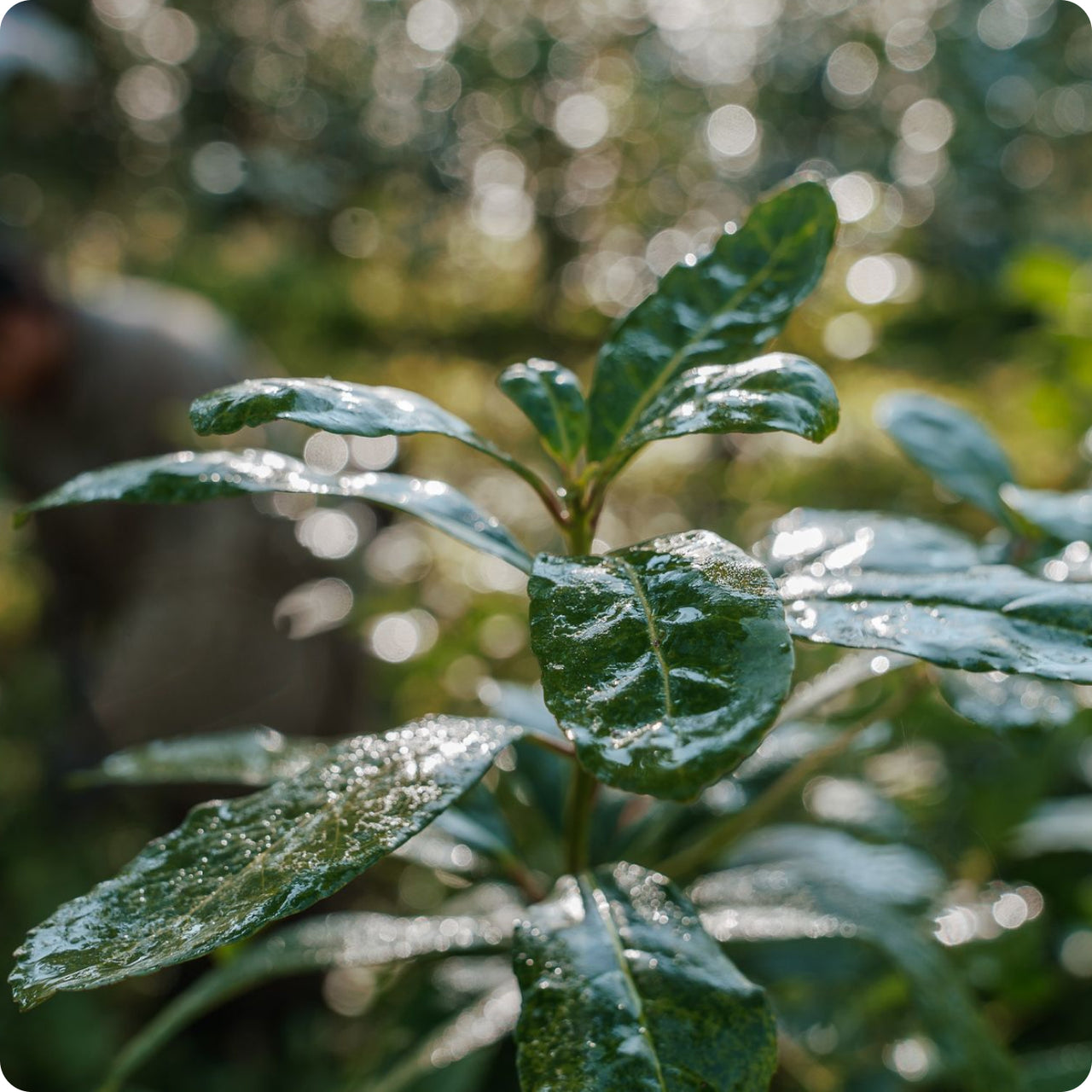
References
1. Carvalho, P. E. R. (2003). Erva-mate: Ilex paraguariensis. Em P. E. R. Carvalho, Espécies arbóreas brasileiras (Vol. 1, p. 455–466). Colombo: Embrapa Florestas. https://www.embrapa.br/florestas/busca-de-publicacoes/-/publicacao/1139739/erva-mate-ilex-paraguariensis
2. Giberti, G. C. (1994). Aquifoliaceae. Em R. Spichiger & L. Ramella, Flora del Paraguay. Conservatoire et Jardin Botaniques & Missouri Botanical Garden. https://www.cjbg.ch/science/editions-scientifiques/flora-del-paraguay
3. Gonzáles de García, M., Gonzáles, Y., & de Arrúa, R. D. (2009). “Yerba Mate”, llex paraguariensis A. St. Hil. Var. Paraguarienses (Arquifoliaceae) caracteres exo. Endomorfológicos y farmacognósticos. Rojasiana, 8(2), 39–51. http://200.10.229.229/files/publicaciones/rojasiana/Vol%208%20(2)%202009/5_Yerba%20Mate_8(2)2010_v13.pdf
4. Grondona, E. M. (1954). Historia de la yerba mate II. Sinonimia, cariología y distribución geográfica. Revista Argentina de Agronomía, 21(1), 9–24. https://babilonia.fcnym.unlp.edu.ar/catalogo/index.php?lvl=notice_display&id=46678
5. Medina, R. D., & Burgos, A. M. (2017). Sistemática y Morfología—De su identidad, suas aspectos externos y alguns más íntimos. Em A. M. Burgos, M. G. Cabrera, P. L. Capellari, H. C. Dalurzo, M. Dávalos, P. Dirchwolf, N. R. Dolce, Á. Fediuk, S. A. Holowaty, V. Llera, M. Maiocchi, R. D. Medina, S. P. Molina, G. Pinto Ruiz, M. Mayol, J. Tarragó, & M. Yacovich, Yerba mate, reseña histórica y estadística, producción e industrialización en el siglo XXI (p. 37–58). Consejo Federal de Inversiones. http://repositorio.unne.edu.ar/handle/123456789/27893
6. Burgos, A. M., Cabrera, M. G., Capellari, P. L., Dalurzo, H. C., Dávalos, M., Dirchwolf, P., Dolce, N. R., Fediuk, Á., Holowaty, S. A., Llera, V., Maiocchi, M., Medina, R. D., Molina, S. P., Pinto Ruiz, G., Mayol, M., Tarragó, J., & Yacovich, M. (2017). Yerba mate, reseña histórica y estadística, producción e industrialización en el siglo XXI. Consejo Federal de Inversiones. http://repositorio.unne.edu.ar/handle/123456789/27893
7. Gerhardt, M. (2013). História ambiental da erva-mate [Tese de Doutorado em História Cultural, Universidade Federal de Santa Catarina]. https://repositorio.ufsc.br/handle/123456789/107480
8. Gerhardt, M. (2022). Erva-Mate e a Conservação dos Ervais Nativos na Argentina. Fronteiras: Journal of Social, Technological and Environmental Science, 11(3), 132–143. https://doi.org/10.21664/2238-8869.2022v11i3.p132-143
9. Instituto Brasileiro de Geografia e Estatística. (2022). Produção da Extração Vegetal e da Silvicultura—PEVS 2021. IBGE. https://sidra.ibge.gov.br/pesquisa/pevs/tabelas
10. Instituto Brasileiro de Geografia e Estatística. (2022). Produção Agrícola Municipal—PAM 2021. IBGE. https://sidra.ibge.gov.br/pesquisa/pam/tabelas
11. Instituto Nacional de Estadística. (2023). Compendio Estadístico—2021. https://www.ine.gov.py/publication-single.php?codec=MjIw
12. Instituto Nacional de la Yerba Mate. (2023). Estadísticas Sector Yerbatero Argentino—Diciembre 2022. INYM. https://inym.org.ar/descargar/publicaciones/estadisticas/2022.html
13. Marques, A. da C., Reis, M. S. dos, & Denardin, V. F. (2019). Yerba mate landscapes: Forest use and socio-environmental conservation. Ambiente & Sociedade, 22, e02822. https://doi.org/10.1590/1809-4422asoc201702822vu2019L3AO10.1590/1809-4422asoc201702822vu2019l3ao
14. Reis, M. S., Montagna, T., Mattos, A. G., Filippon, S., Ladio, A. H., da Cunha Marques, A., Zechini, A. A., Peroni, N., & Mantovani, A. (2018). Domesticated landscapes in araucaria forests, southern Brazil: A multispecies local conservation-by-use system. Frontiers in Ecology and Evolution, 6(FEB), 1–14. https://doi.org/10.3389/fevo.2018.00011
15. Zelada Cardoso, N. de J., & González Villalba, J. D. (2019). Guía técnica cultivo de yerba mate. FCA, UNA.
16. Avé-Lallemant, R. (1995). 1858, Viagem pelo Paraná. Fundação Cultural.
17. Dobrizhoffer, M. (1822). An Account of the Abipones, An Equestrian People of Paraguay, Vol. 1. John Murray.
18. Hernández, P. (1913). Organización Social de las Doctrinas Guaraníes de la Compañía de Jesus: Vol. Tomo II. Gustavo Gili.
19. Isabelle, A. (1835). Voyage à Buénos-Ayres et a Porto-Alègre, par la Banda-Oriental, les Missions d’Uruguay et la Province de Rio-Grande-do-Sul (1830-1834). Imprimèrie de J. Morlent. Pp 618.
20. Montoya, A. R. de. (1639). Conquista espiritual hecha por los religiosos de la Compañia de Iesus en las Provincias del Paraguay, Parana, Uruguay, y Tape. En la imprenta del Reyno. http://www.etnolinguistica.org/biblio:montoya-1639-conquista/p/2
21. Nimmo, E. R., & Nogueira, J. F. M. M. (2019). Creating hybrid scientific knowledge and practice: The Jesuit and Guaraní cultivation of yerba mate. Canadian Journal of Latin American and Caribbean Studies / Revue canadienne des études latino-américaines et caraïbes, 44(3), 347–367. https://doi.org/10.1080/08263663.2019.1652018
22. Noelli, F. S. (1993). Sem Tekohá não há Tekó (Em Busca de um Modelo Etnoarqueológico de Aldeia e de Subsistência Guaraní e sua Aplicação a uma área de Domínio no Delta do Rio Jacuí (RS) [Mestrado em História]. Pontifícia Universidade Católica do Rio Grande do Sul.
23. Ricca, J. (2012). El mate. Sudamericana.
24. Saint-Hilaire, A. de. (1822). Aperçu d’un voyage dan l’interieur du Brésil, la province Cisplatina et les Missions dites du Paraguay. Em Muséum national d’histoire naturelle, Mémoires du Muséum d’Histoire Naturelle (Vol. 9, p. 337–380). G. Dufour. https://bibliotheques.mnhn.fr/medias/doc/EXPLOITATION/IFD/MEMMH_S000_1822_T009_N000/memoires-du-museum-d-histoire-naturelle
25. Keller, H. A. (2013). Ka’ aguachu: “La selva en un sólo árbol”. Una contribución de la mitología Ava Chiripa a la toponimia de la región guaranítica. Estudios Socioterritoriales, 13, 101–123. https://ojs2.fch.unicen.edu.ar/ojs-3.1.0/index.php/estudios-socioterritoriales/article/view/1379
26. Nacif, R. T. (2020). Yvy vai – A Terra imperfeita: Território e paisagem alimentar Guarani. Universidade Estadual Paulista “Júlio de Mesquita Filho”.
27. Noelli, F. S., Votre, G. C., Santos, M. C. P., Pavei, D. D., & Campos, J. B. (2019). Ñande reko: Fundamentos dos conhecimentos tradicionais ambientais Guaraní. Revista Brasileira de Linguística Antropológica, 11(1), 13–45. https://doi.org/10.26512/rbla.v11i1.23636
28. Gaudêncio, J. da S., Rodrigues, S. P. J., Foggiatto Silveira, R. M. C., & Martins, D. R. (2020). Etnociência Kaingang: Uma revisão sistemática de literatura. Revista Cadernos do Ceom, 33(53), 157–171. https://doi.org/10.22562/2020.53.12
29. Soto, J. G., & Lattke, F. C. (2009). El Bosque. Em ESTUDIO SOCIONATURAL COMUNIDAD ACHÉ DE YPETIMÍ.
30. Barreto, M. (1989). El mate: Su historia y cultura. Ediciones del Sol.
31. Folch, C. (2010). Stimulating Consumption: Yerba Mate Myths, Markets, and Meanings from Conquest to Present. Comparative Studies in Society and History, 52(1), 6–36.
32. Linhares, T. (1969). História Econômica do Mate. Livraria José Olympio.
33. Sarreal, J. J. S. (2014). The Guaraní and their Missions: A socioeconomic history. Stanford University Press.
34. Small, E., & Catling, P. M. (2001). Blossoming treasures of biodiversity: 3. Maté (Ilex paraguariensis) - better than Viagra, marijuana, and coffee? Biodiversity, 2(4), 26–27. https://doi.org/10.1080/14888386.2001.9712675
35. Berman, A. (2021). Mate e Comunicação. Tradução em Revista, 2021(30). https://doi.org/10.17771/PUCRio.TradRev.53015
36. Giai, M. (2020). Sobre el agotamiento espectrofotométrico del mate. Revista Cubana de Alimentación y Nutrición, 30(2), 539–547.
37. Nimmo, E. R., Lacerda, A. E. B., Rosot, M. A. D., Carvalho, A. I., Gomes, E. P., Gomes, F. B., Nogueira, J. F. M. M., & Gomes, T. (2022). Erva-mate sombreada: SIPAM “Sistemas tradicionais e agroecológicos de erva-mate na Floresta com Araucária, Brasil”. Embrapa Florestas.
From the rainforest to your gourd

Cultivating
Our yerba mate is grown in its native home in the Atlantic Forest [1,2] in Argentina, Brazil and Paraguay, where we partner with Indigenous Peoples and Local Communities (IPLCs)[1], who continue to use traditional cultivation and promote regenerative, organic [5–12] and fair trade practices [12–15].
Unlike conventional, monoculture, high-input, sun-grown yerba mate [16–23], regenerative, organic shade-grown yerba mate is cultivated (planted and managed) within natural forest or restored areas, helping to protect important forest ecosystems and support the continuation of traditional cultural practices [8,24–31]2.
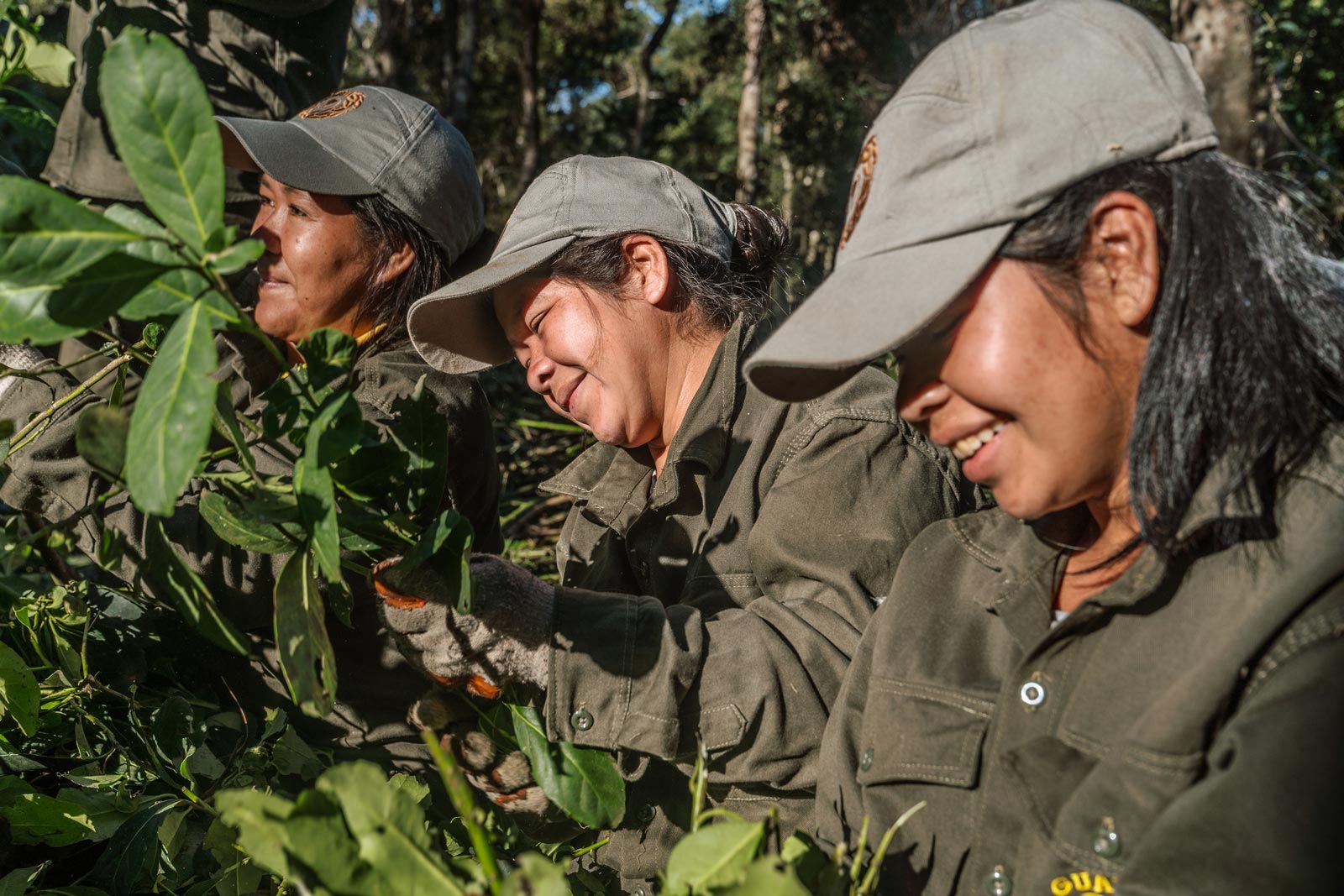
Harvesting
Mature leaves and branches from yerba mate trees are harvested manually every one to three years [8,24,26,35].
Harvesters rely on a wide range of knowledge passed down for generations to prune and manage trees. They take care to leave enough foliage on each tree to ensure healthy resprouting for the next harvest [8,26].
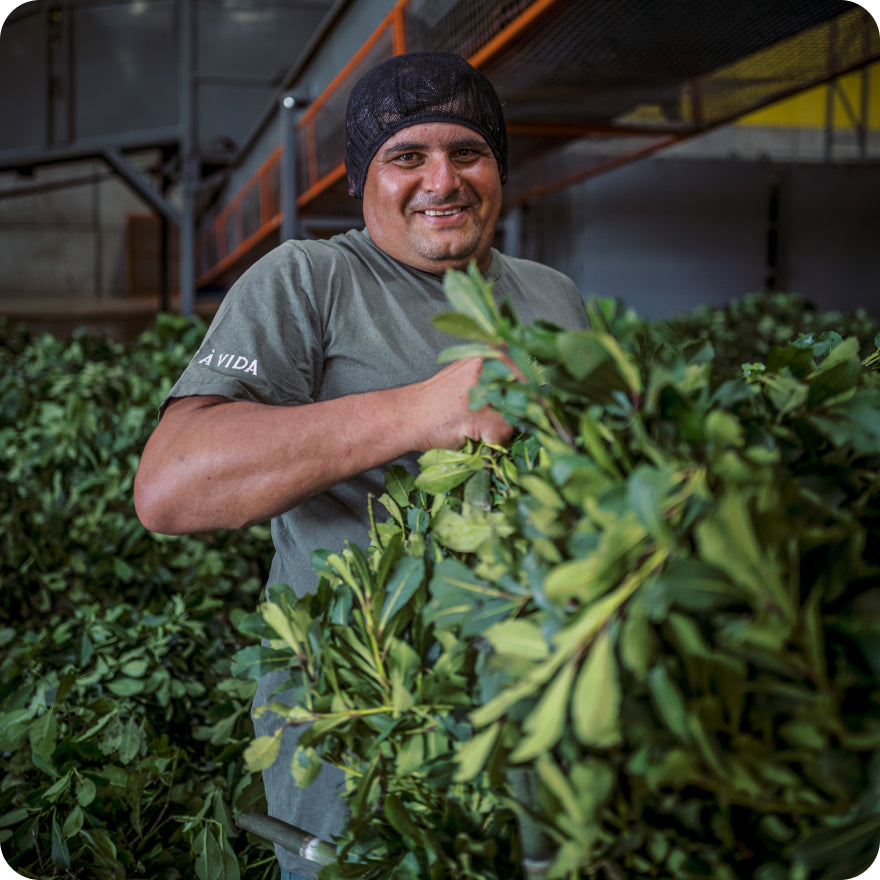
Processing
The transformation of green leaves into yerba mate is a traditional process developed by the Guarani Indigenous Peoples hundreds of years ago, and today, a similar process continues using heat to dry green leaves [9–11,35–37].
For our yerba mate, the leaves are dried after harvesting at different partner facilities in Argentina and Paraguay, and at our own facility in Turvo, Paraná, Brazil. Guayakí Yerba Mate is air dried so it is smoke-free and safe from PAHs, which are chemical substances resulting from burnt matter that can be harmful to health. Drying follows the traditional process and is done in two steps: a first flash drying, called sapeco, and then slow drying, or secado, that can take several hours [9,26].
Dried leaves and stems are ground into yerba canchada, a course grind, before being aged for 6-12 months to acquire the desired flavor and color.
After aging, yerba canchada goes through final grinding, a careful process to reach the right particle size and balance between leaves, stems and powder.

Consuming or Drinking
There are many ways to consume yerba mate. Many people enjoy it as mate or chimarrão, a hot infusion of the loose leaves in a gourd (mate [ma-tay] or cuia [ku-yah]) with a metal straw called a bombilla (bom-bee-yah) or bomba (bom-ba), as a cold infusion, called tereré, or as a hot or iced tea [5,11,38].
Our yerba mate is ready to be enjoyed with friends in its traditional loose leaf form out of a gourd, as a tea in individual yerba mate tea bags, or infused into our line of cold ready-to-drink beverages.




References
1. Grondona, E. M. (1954). Historia de la yerba mate II. Sinonimia, cariología y distribución geográfica. Revista Argentina de Agronomía, 21(1), 9–24. https://babilonia.fcnym.unlp.edu.ar/catalogo/index.php?lvl=notice_display&id=46678
2. Oliveira, Y. M. M. de, & Rotta, E. (1985). Área de distribuição natural de erva-mate (Ilex paraguariensis St. Hil.). Anais do X Seminário sobre atualidades e perspectivas florestais: silvicultura da erva-mate (Ilex paraguariensis St. Hil.), 17–36. https://www.infoteca.cnptia.embrapa.br/infoteca/handle/doc/298088
3. Fromentin, J.-M., Emery, M. R., Donaldson, J., Hallosserie, A., Michaud-Lopez, C. E., Parma, A., St. Martin, K., & Stokland, H. (2022). IPBES Sustainable Use of Wild Species Assessment—Chapter 1. Setting the Scene. Zenodo. https://doi.org/10.5281/ZENODO.6425671
4. IPBES. (2021). Draft: Methodological guidance for recognizing and working with indigenous and local knowledge in IPBES. IPBES. https://www.ipbes.net/sites/default/files/inline-files/IPBES_ILK_MethGuide.pdf
5. Barretto, M. (1989). El mate: Su historia y cultura. Del Sol.
6. Keller, H. A. (2013). Ka’ aguachu: “La selva en un sólo árbol”. Una contribución de la mitología Ava Chiripa a la toponimia de la región guaranítica. Estudios Socioterritoriales, 13, 101–123. https://ojs2.fch.unicen.edu.ar/ojs-3.1.0/index.php/estudios-socioterritoriales/article/view/1379
7. Nimmo, E. R., Carvalho, A. I. de, Laverdi, R., & Lacerda, A. E. B. (2022). Conhecimento, memória e história: Uma visão transdisciplinar sobre os sistemas tradicionais e agroecológicos de erva-mate. Embrapa Florestas. https://ainfo.cnptia.embrapa.br/digital/bitstream/doc/1145528/1/EmbrapaFlorestas-2022-Documentos373.pdf
8. Nimmo, E. R., Lacerda, A. E. B., Rosot, M. A. D., Carvalho, A. I. de, Gomes, E. P., Gomes, F. B., Nogueira, J. F. M. M., Luiz, R. G., & Gomes, T. (2022). Erva-mate sombreada: Sipam “Sistemas tradicionais e agroecológicos de erva-mate na Floresta com Araucária, Brasil”. Embrapa Florestas. https://ainfo.cnptia.embrapa.br/digital/bitstream/item/245283/1/EmbrapaFlorestas-2022-Documentos374.pdf
9. Nimmo, E. R., & Nogueira, J. F. M. M. (2019). Creating hybrid scientific knowledge and practice: The Jesuit and Guaraní cultivation of yerba mate. Canadian Journal of Latin American and Caribbean Studies / Revue canadienne des études latino-américaines et caraïbes, 44(3), 347–367. https://doi.org/10.1080/08263663.2019.1652018
10. Noelli, F. S., Votre, G. C., Santos, M. C. P., Pavei, D. D., & Campos, J. B. (2019). Ñande reko: Fundamentos dos conhecimentos tradicionais ambientais Guaraní. Revista Brasileira de Linguística Antropológica, 11(1), 13–45. https://doi.org/10.26512/rbla.v11i1.23636
11. Ricca, J. (2012). El mate. Sudamericana.
12. Montagnini, F., Eibl, B. I., & Barth, S. R. (2011). Organic yerba mate: An environmentally, socially and financially suitable agroforestry system. Em S. F. Ashton, S. W. Workman, & D. J. Moorhead (Orgs.), Agroforestry: A Profitable Land Use. Proceedings (p. 161–169).
13. Alwang, J., Villacis, A., & Barrera, V. (2022). Credence attributes and opportunities: A cautionary tale of yerba mate in Paraguay. Journal of Agribusiness in Developing and Emerging Economies, 12(4), 567–583. https://doi.org/10.1108/JADEE-11-2021-0291
14. Fochesatto, A. (2019). Yerba Mate: National Project to Emerging Superfood [Master of Arts, Illinois State University]. https://doi.org/10.30707/ETD2019.Fochesatto.A
15. Smith, F. (2014). Exploring Fair Trade Yerba Mate Networks in Misiones, Argentina [Dissertação (Mestrado em Latin American Studies), University of Miami]. https://scholarship.miami.edu/esploro/outputs/graduate/Exploring-Fair-Trade-Yerba-Mate-Networks-in-Misiones-Argentina/991031447938602976
16. Embrapa Florestas. (2014). Cultivo da Erva-Mate (2a. ed.). Embrapa Florestas. https://www.spo.cnptia.embrapa.br/home
17. Mazuchowski, J. Z. (1989). Manual da erva-mate (Ilex paraguariensis St. Hill.). Empresa Paranaense de Assistência Técnica e Extensão Rural.
18. Penteado Junior, J. F., & Goulart, I. C. G. dos R. (2019). Erva 20: Sistema de produção para erva-mate. Embrapa. https://www.embrapa.br/busca-de-publicacoes/-/publicacao/1106677/erva-20-sistema-de-producao-para-erva-mate
19. Prat Kricun, S. D. (2008). Yerba Mate – Guía para la aplicación de buenas prácticas agrícolas y buenas prácticas de manufactura. INTA EEA - Cerro Azul.
20. Servicio Nacional de Calidad y Sanidad Vegetal y de Semillas. (2017). Resolución no 534—Por la cual se aprueba el rotocolo de buenas prácticas agrícolas para el cultivo de yerba mate (Ilex paraguariensis), del Servicio Nacional de Calidad y Sanidad Vegetal y de Semillas (SENAVE). http://web.senave.gov.py:8081/docs/resoluciones/senave/2017_RES N 534 - Protocolo BPA Yerba Mate.pdf
21. Superintendencia de Riesgos de Trabajo. (2019). Manual de buenas práctivcas – Actividad Yerbatera / Cultivo y cosecha. Ministerio de Producción y Trabajo.
22. Zelada Cardoso, N. de J., & González Villalba, J. D. (2019). Guía técnica cultivo de yerba mate. FCA, UNA.
23. Zelada, N., Mendoza, L., & Echeverria, P. (2016). Guía de Buenas Prácticas Agrícolas en Producción de Yerba Mate. Centro Multidisciplinario de Investigaciones Tecnológicas (CEMIT) - Instituto de Investigación para el Desarrollo.
24. Brítez, E. (Org.). (2017). Primer foro de producción de yerba mate Asociada al Monte Nativo: Memoria. Guyra Paraguay. https://guyra.org.py/wp-content/uploads/2018/12/Memoria-foro-yerba-mate-.pdf
25. Cabral, H., Coronel‐Bejarano, D., Ruiz, R., Cañete, L., Britez, E., & Rojas, V. (2020). Living in the shadows: Diversity of amphibians, reptiles and birds in shade‐grown yerba mate ( Ilex paraguariensis ) plantations. Austral Ecology, 45(8), 1123–1134. https://doi.org/10.1111/aec.12942
26. Chaimsohn, F. P., & Souza, A. M. de. (2013). Sistemas de produção tradicionais e agroflorestais de erva-mate no centro-sul do Paraná e norte catarinense: Contribuições para a construção de um processo de indicação geográfica. [os editores].
27. Coelho, G. C. (2017). Ecosystem services in Brazilian’s southern agroforestry systems. Tropical and Subtropical Agroecosystems, 20(3), 475–492. https://doi.org/10.56369/tsaes.2421
28. Ilany, T., Ashton, M. S., Montagnini, F., & Martinez, C. (2010). Using agroforestry to improve soil fertility: Effects of intercropping on Ilex paraguariensis (yerba mate) plantations with Araucaria angustifolia. Agroforestry Systems, 80(3), 399–409. https://doi.org/10.1007/s10457-010-9317-8
29. Lacerda, A. E. B. (2016). Conservation strategies for Araucaria Forests in Southern Brazil: Assessing current and alternative approaches. Biotropica, 48(4), 537–544. https://doi.org/10.1111/btp.12317
30. Marques, A. da C., Reis, M. S. dos, & Denardin, V. F. (2019). Yerba mate landscapes: Forest use and socio-environmental conservation. Ambiente & Sociedade, 22, e02822. https://doi.org/10.1590/1809-4422asoc201702822vu2019L3AO10.1590/1809-4422asoc201702822vu2019l3ao
31. Montagnini, F., & del Fierro, S. (2022). Functions of Agroforestry Systems as Biodiversity Islands in Productive Landscapes. Em F. Montagnini (Org.), Biodiversity Islands: Strategies for Conservation in Human-Dominated Environments (Vol. 20, p. 89–116). Springer International Publishing. https://link.springer.com/10.1007/978-3-030-92234-4
32. Cockle, K. L., Leonard, M. L., & Bodrati, A. A. (2005). Presence and Abundance of Birds in an Atlantic Forest Reserve and Adjacent Plantation of Shade-Grown Yerba Mate, in Paraguay. Biodiversity & Conservation, 14(13), 3265–3288. https://doi.org/10.1007/s10531-004-0446-0
33. Signor, P., Gomes, G. S., & Watzlawick, L. F. (2015). Produção de erva-mate e conservação de Floresta com Araucária. Pesquisa Florestal Brasileira, 35(83), Artigo 83. https://doi.org/10.4336/2015.pfb.35.83.898
34. Silva, L. C. V., Kubota, V. R., Aranda, J. E. I., & Dueňas, D. A. S. (2019). Efectos del cultivo de yerba mate (Ilex paraguariensis) bajo sombra sobre la mesofauna edáfica en la RESERVA DE BIÓsfera del Bosque Mbaracayú. Boletín del Museo Nacional de Historia Natural del Paraguay, 23(2), 78–89. https://www.mades.gov.py/wp-content/uploads/2019/12/23278-89_2019126_Velezquez_Edafica.pdf
35. Montoya, A. R. de. (1639). Conquista espiritual hecha por los religiosos de la Compañia de Iesus en las Provincias del Paraguay, Parana, Uruguay, y Tape. En la imprenta del Reyno. http://www.etnolinguistica.org/biblio:montoya-1639-conquista/p/2
36. Avé-Lallemant, R. (1995). 1858, Viagem pelo Paraná. Fundação Cultural.
37. Isabelle, A. (1835). Voyage à Buénos-Ayres et a Porto-Alègre, par la Banda-Oriental, les Missions d’Uruguay et la Province de Rio-Grande-do-Sul (1830-1834). Imprimèrie de J. Morlent. Pp 618.
38. Folch, C. (2010). Stimulating Consumption: Yerba Mate Myths, Markets, and Meanings from Conquest to Present. Comparative Studies in Society and History, 52(1), 6–36. http://www.jstor.org/stable/40603070
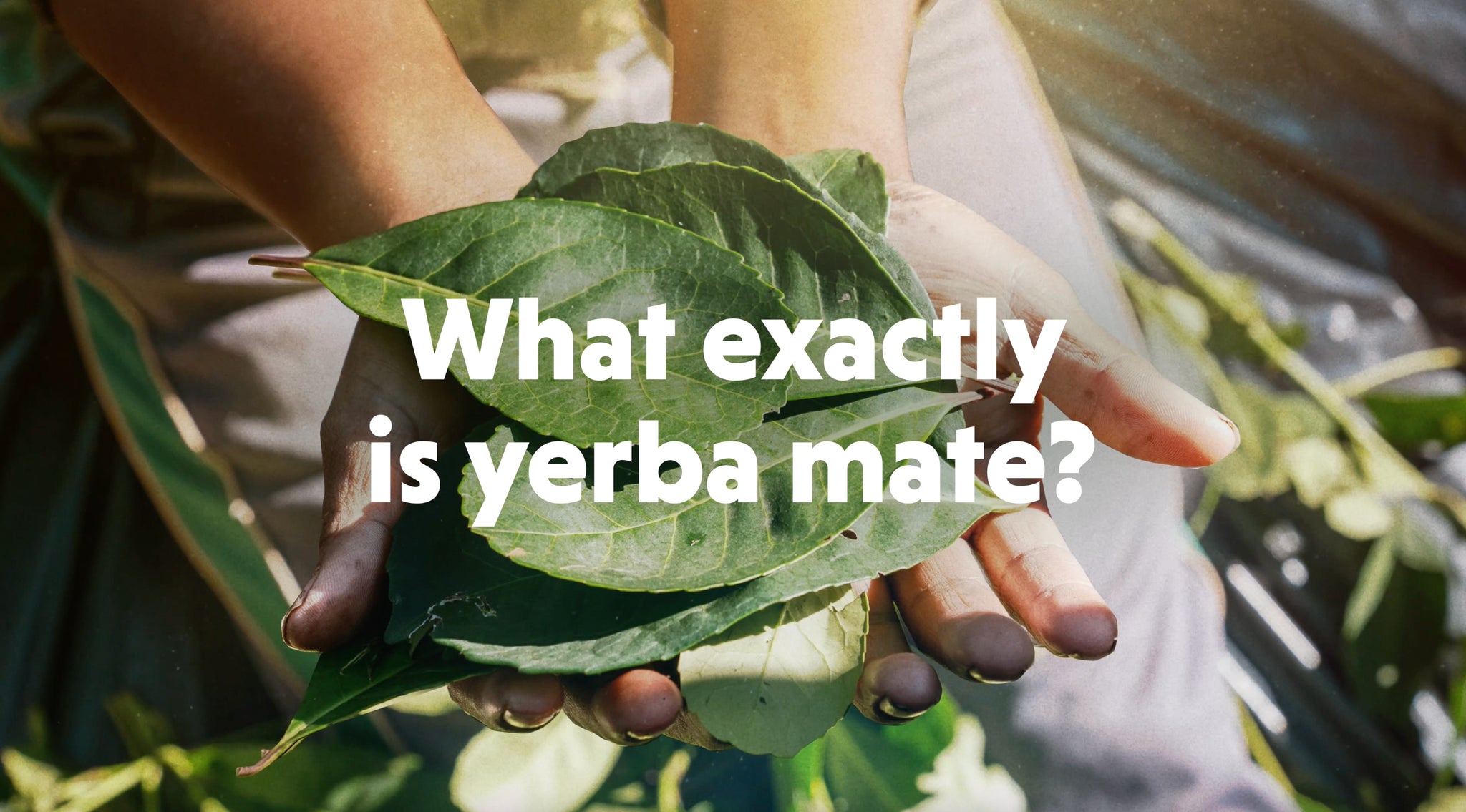
References
1. Barreto, M. (1989). El mate: Su historia y cultura. Ediciones del Sol.
2. Berman, A. (2021). Mate e Comunicação. Tradução em Revista, 2021(30). https://doi.org/10.17771/PUCRio.TradRev.53015
3. Eunice Maciel, M. (2022). Chimarrão. https://doi.org/10.59130/2965-128X-V01-N01-CHIMARRAO02
4. Giai, M. (2020). Sobre el agotamiento espectrofotométrico del mate. Revista Cubana de Alimentación y Nutrición, 30(2), 539–547.
5. Strachulski, J. (2016). Momentos De Sorver O Mate: A Prática Do Chimarrão Como Elemento De União Comunal Entre Os Moradores Da Comunidade Rural Linha Criciumal, Cândido De Abreu—Pr. Revista Contribuciones a las Ciencias Sociales.
6. Keller, H. A. (2013). Ka’ aguachu: “La selva en un sólo árbol”. Una contribución de la mitología Ava Chiripa a la toponimia de la región guaranítica. Estudios Socioterritoriales, 13, 101–123. https://ojs2.fch.unicen.edu.ar/ojs-3.1.0/index.php/estudios-socioterritoriales/article/view/1379
7. Noelli, F. S., Votre, G. C., Santos, M. C. P., Pavei, D. D., & Campos, J. B. (2019). Ñande reko: Fundamentos dos conhecimentos tradicionais ambientais Guaraní. Revista Brasileira de Linguística Antropológica, 11(1), 13–45. https://doi.org/10.26512/rbla.v11i1.23636
8. Martins, R. (1926). Ilex mate: Chá sul-americano. Empresa Graphica Paranaense.
9. Gaudêncio, J. da S., Rodrigues, S. P. J., Foggiatto Silveira, R. M. C., & Martins, D. R. (2020). Etnociência Kaingang: Uma revisão sistemática de literatura. Revista Cadernos do Ceom, 33(53), 157–171. https://doi.org/10.22562/2020.53.12
10. Nacif, R. T. (2020). Yvy vai – A Terra imperfeita: Território e paisagem alimentar Guarani. Universidade Estadual Paulista “Júlio de Mesquita Filho”.
11. Noelli, F. S. (1993). Sem Tekohá não há Tekó (Em Busca de um Modelo Etnoarqueológico de Aldeia e de Subsistência Guaraní e sua Aplicação a uma área de Domínio no Delta do Rio Jacuí (RS) [Mestrado em História]. Pontifícia Universidade Católica do Rio Grande do Sul.
12. Strachulski, J., Silva, A. de A., Floriani, N., & Alves, J. N. K. (2018). OS KAINGANG DA TERRA INDÍGENA FAXINAL: A CONFIGURAÇÃO ATUAL DAS PRÁTICAS SOCIOCULTURAIS TERRITORIAIS. Caminhos de Geografia, 19(68), 307–325. https://doi.org/10.14393/RCG196821
13. Veiga, J. (1994). Organização Social e Cosmovisão Kaingang: Uma introdução ao parentesco, casamento e nominação em uma sociedade Jê Meridional [Mestrado em Antropologia Social]. Universidade Estadual de Campinas.
14. Assunção, A. V., Arnoni, R. K., & Machado Júnior, L. A. P. (2017). Uma cultura mutante: O chimarrão e seus artefatos analisados sob o viés do design vernacular e do imaginário. Revista Poliedro, 1(01),29. https://doi.org/10.15536/2594-4398.2017.v1.n01.pp.29-47

A different kind of boost
Within the yerba mate plant is a combination of caffeine (also found in coffee), theobromine (also found in chocolate), and polyphenols (also found in green tea). As any yerba mate lover will tell you, it provides a uniquely smooth boost of energy and focus.
Preparing Yerba Mate
The choice of vessel and ways of preparing yerba mate is based on the knowledge and tradition of Indigenous Peoples that still inspire the consumption of yerba mate today. Several ways of preparing and drinking yerba mate have been developed over time. You can drink it as a tea brewed how you prefer, or you can try the traditional method in a gourd as shown below.
What you’ll need:
- Guayakí loose leaf yerba mate
- Gourd (or mason jar or any other glass, ceramic or stainless steel vessel)
- Cool water
- Hot water / Cold water
- Bombilla
- Guayakí loose leaf yerba mate
- Gourd (or mason jar or any other glass, ceramic or stainless steel vessel)
- Cool water
- Hot water / Cold water
- Bombilla
1/6
References
[1]The vessel used to drink mate is known by different names depending on the region. In Portuguese it is called a cuia, and in Spanish mate. To consume a cold infusion (terere), it is called a guampa [1,2,6].
[2] The bombilla, or bomba in Portuguese, is a metal straw with a filter at its base used to sip the infusion
1. Assunção, A. V., Arnoni, R. K., & Machado Júnior, L. A. P. (2017). Uma cultura mutante: O chimarrão e seus artefatos analisados sob o viés do design vernacular e do imaginário. Revista Poliedro, 1(01), 29. https://doi.org/10.15536/2594-4398.2017.v1.n01.pp.29-47
2. Barreto, M. (1989). El mate: Su historia y cultura. Ediciones del Sol.
3. Folch, C. (2010). Stimulating Consumption: Yerba Mate Myths, Markets, and Meanings from Conquest to Present. Comparative Studies in Society and History, 52(1), 6–36.
4. Ricca, J. (2012). El mate. Sudamericana.
5. Gerhardt, M. (2013). História ambiental da erva-mate [Tese de Doutorado em História Cultural, Universidade Federal de Santa Catarina]. https://repositorio.ufsc.br/handle/123456789/107480
6. Jamieson, R. W. (2001). The Essence of Commodification: Caffeine Dependencies in the Early Modern World. Journal of Social History, 35(2), 269–294.











